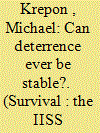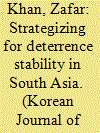| Srl | Item |
| 1 |
ID:
139037


|
|
|
|
|
| Summary/Abstract |
Stability has been the holy grail of deterrence strategists since the outset of the US–Soviet nuclear-arms competition. This prize has been elusive because nuclear weapons are not stabilising. The bomb has had limited, but important, utility in preventing large-scale conventional war, and by fostering cautious behaviour in severe crises.
|
|
|
|
|
|
|
|
|
|
|
|
|
|
|
|
| 2 |
ID:
090233


|
|
|
|
|
| Publication |
2009.
|
| Summary/Abstract |
Strategic stability in South Asia is hardly stable; and ever prone to further destabilization. Twice since going nuclear in 1998, India and Pakistan have faced the danger of an inadvertent nuclear war. Nuclear weapons have been significant in all India-Pakistan confrontations/conflict since the mid-1980 - Brasstacks 1986-87, Compound Crisis 1990, Kargil 1999 and Military Standoff 2002 - when they were inducted into the strategic discourse in the region.
|
|
|
|
|
|
|
|
|
|
|
|
|
|
|
|
| 3 |
ID:
147398


|
|
|
|
|
| Summary/Abstract |
Before the arrival of nuclear weapons in South Asia, both India and Pakistan had fought several wars. The arrival of nuclear weapons has made both the South Asian nuclear weapons states more cautious to fight. This caution and restraint is directly associated with the fear of using nuclear weapons, the damage of which remains unacceptable to both the adversaries. Although nuclear weapons are considered for deterrence purposes and they are assumed to provide deterrence stability, they are not a guaranteed panacea for all the outstanding issues including the core issue of Kashmir. This absence of a guaranteed solution for these problems despite the presence of nuclear weapons entails the deterrence instability in South Asia, even though neither India nor Pakistan are directly fighting anymore because of the fear of major military escalation to a nuclear use. This paper talks about at least three major dynamics associated with nuclear weapons that might help promote deterrence stability in South Asia. It asks for the consistent practice of minimum deterrence that was initially conceptualized, focuses on the practices of defensive doctrinal postures between India and Pakistan, and calls for an arms control regime (ACR) that does not yet exist in South Asia. In addition to other peaceful measures discussed in the existing literature, the amalgamation of these three ingredients and the commonalities within them could play an important role in promoting deterrence stability in South Asia.
|
|
|
|
|
|
|
|
|
|
|
|
|
|
|
|